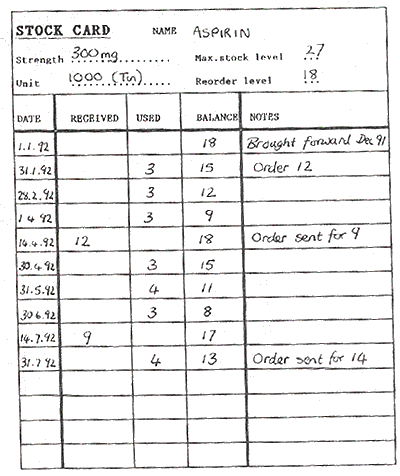by Sandra Michie.
Does record keeping seem one of the most un-interesting and perhaps difficult parts of running a small health centre or even a business? Yet it can be fun Keeping good records with a simple method to keep stocks up to date, means that you can take much of the stress out of the running of any small business or health centre.
Plan carefully just what is needed, and then work out the simplest way to keep records. Only people who work in a situation are able to understand thoroughly the needs of that particular health centre or business.
You can get basic ideas from other people, but they will only really work for you if you stop and plan out your own system. Here are some ideas to help you.
First, let try and understand the simple facts about keeping stock records. We call the item you are counting and using. Record-keeping is simply;
Stock in hand + Stock received - Stock used = Balance left
To keep these correct, you also need to know how much you use in a certain time, and when to order and how much to re-order. When the amount of stock reaches the re-order level, it is time to order that item.
Planning
Let's talk in particular about a small health centre. What are the things for which we need to keep stock records?There are:
- medicines
- bandages and dressings
- laboratory supplies and chemicals
- bed linens and cleaning materials
- food supplies
…you will think of others.
It is very important that the amount of supplies is adequate for the demand. In many situations this is hard to plan, especially where supplies are not easily available, but some careful thought can make it much simpler. Here are some questions to help in the planning:
- How essential is the item? (Some items are very important indeed, like chloroquin for the treatment of malaria.
- Others are necessary but not essential, like sheets for the beds.)
- How long does it take from ordering to arrival?
- How often do you order supplies?
- When is the best time in the year to order them?
- What quantity of that item do you need each month?
- How adequate and secure are your storage facilities?
Once you have worked out the amounts you need each month, it is important to plan well so that stock is ordered in good time. There can be many factors affecting ordering
- Seasons of the year - muddy roads in a rainy season can make transport of supplies very difficult, so the height of the rainy season is not the best time for orders.
- Storage space - if you are unable to securely store stock, there is little point in ordering larger quantities for more to be stolen.
- Transport facilities - in an isolated area, it is often easier to arrange for a large order to be delivered safely, rather than risk ordering small amounts that may even be stolen off the lorry. Don't order too often - it adds to the work.
Ideas for stock storage
- Have a well locked store room.
- Work out your maximum stock level. This helps you to plan your storage space well and allows a little extra stock in case of unexpected delays.
- Plan your re-order level. When you re-order there should be enough of the item left on the shelves for use until the new order arrives. In addition, allow a generous amount in case the order fails to come when expected.
- Store all the stock of each item together in one place - you can then see it all quickly.
- Always store new stock at the back, and use the items with the shortest expiry date first.
- Label your shelves.
- Display the re-order number clearly by the stock so that you know immediately when you need to re-order (see suggested re-order stock level below).
- Keep a list where you note down whatever item reaches the re-order level.
- Thoroughly check stock every year and think about whether the stock levels need changing.
- Do not trust your memory - check things carefully before ordering. It is easy to forget something essential!
Suggested stock levels for medicines:
Maximum Stock Level - the maximum ever held in storage.;
The stock total will not usually be this high. This figure is the amount to aim at when re-ordering.
Maximum Stock Level = Amount used each month x Months between orders x 3 eg: If you use 3 tins in a month and make an order every 3 months, it would be 3 (tins) x 3 (months) x 3 = 27 tins
If you use 1 tin a month and order every month, it would be 3 tins as stock level (i.e. maximum ever in store)
Re-order Stock Level - this figure gives a quick reference to see when you need to re-order.
When the stock reaches this level, or below, you will need to re-order supplies on the next ordering date.
Re-order Level = (amount used each month) x (Months between orders) x 2 3 (tins) x 3 (months) x 2 = 18 tins 1 (tin) x 1 (month) x 2 = 2 tins left on the shelf - means it is time to re-order. Write this number on the stock label on the shelf.









